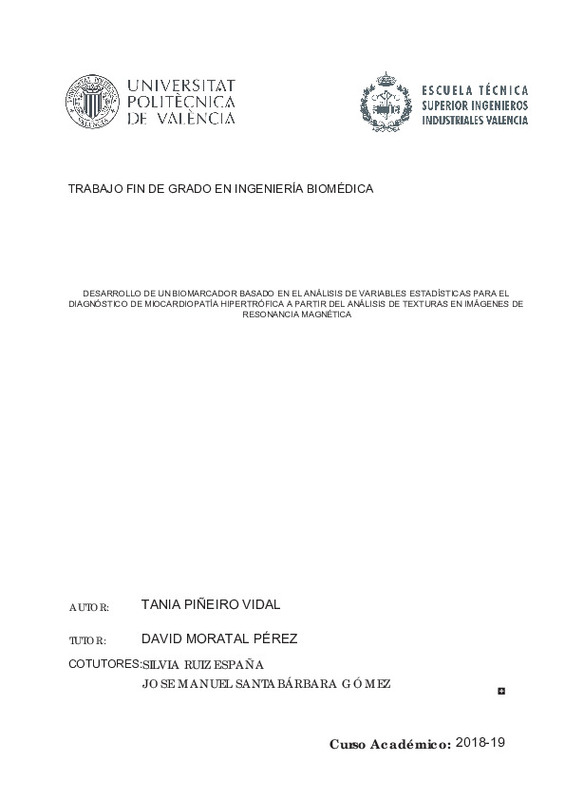|
Resumen:
|
[ES] Dada la elevada prevalencia de las enfermedades cardiovasculares en la actualidad, se hace cada vez más necesario el desarrollo de sistemas de ayuda a la decisión que proporcionen una información adicional al médico ...[+]
[ES] Dada la elevada prevalencia de las enfermedades cardiovasculares en la actualidad, se hace cada vez más necesario el desarrollo de sistemas de ayuda a la decisión que proporcionen una información adicional al médico con el fin de poder diagnosticarlas adecuadamente y realizar el tratamiento más apropiado. En este caso, se pretende desarrollar un biomarcador para el diagnóstico de miocardiopatía hipertrófica.
La miocardiopatía hipertrófica (MCH) es una enfermedad del músculo del corazón que se caracteriza por el aumento del grosor de sus paredes, que no se deba a una causa externa al músculo (por ejemplo, hipertensión, valvulopatías, etc.). Se estima que la miocardiopatía hipertrófica afecta a 1 de cada 500 personas. No puede atribuirse a una causa evidente, pero es hereditaria en un alto porcentaje de casos. Existen varías patologías que provocan el engrosamiento del músculo cardíaco, por lo que un biomarcador que permita identificar la miocardiopatía hipertrófica podría ser de gran utilidad.
Con el análisis de texturas a partir de imágenes médicas se pretende llegar a distinguir entre pacientes con miocardiopatía hipertrófica y sanos, sin tener que recurrir a pruebas invasivas en el paciente.
Para investigar la capacidad del análisis de texturas para diferenciar pacientes con MCH, se ha realizado un estudio retrospectivo que incluirá pacientes que sufren MCH y el mismo número de pacientes sanos.
Se empleará una técnica de segmentación semiautomática que proporciona más fiabilidad mediante el uso del software Segment. El miocardio del ventrículo izquierdo se segmentará de acuerdo con el modelo de 17 segmentos a partir de secuencias de cine de RM de imágenes en eje corto.
Una vez obtenida la segmentación, se realizará un análisis de texturas del miocardio y se obtendrán variables estadísticas con las que se evaluará la posibilidad de distinguir MCH y pacientes sanos.
Para la clasificación se empleará un clasificador basado en técnicas de aprendizaje máquina mediante el uso diferentes combinaciones de características de textura para obtener un modelo que proporcione una clasificación óptima.
[-]
[EN] Given the high prevalence of cardiovascular diseases, it is becoming necessary to develop decision support systems which are able to provide additional information to the doctor, in order to be able to diagnose them ...[+]
[EN] Given the high prevalence of cardiovascular diseases, it is becoming necessary to develop decision support systems which are able to provide additional information to the doctor, in order to be able to diagnose them adequately and perform the most appropriate treatment. In this case, we aim to develop a biomarker for the diagnosis of hypertrophic cardiomyopathy.
Hypertrophic cardiomyopathy (HCM) is a disease of the heart muscle that is characterized by an increase in the thickness of its walls, which is not caused by any external element of the muscle (for example, hypertension, valvular heart disease, etc.). It is estimated that hypertrophic cardiomyopathy affects 1 in 500 people. It cannot be attributed to an obvious cause, but it is hereditary in a high percentage of cases. There are several pathologies that cause thickening of the heart muscle, so a biomarker that allows identification of hypertrophic cardiomyopathy could be very useful.
With the analysis of textures from medical images we aim to distinguish between patients with hypertrophic and healthy cardiomyopathy, without having to perform invasive testing in the patient.
To investigate the ability of texture analysis to differentiate patients with HCM, a retrospective study has been conducted. It will include patients suffering from HCM and the same number of healthy patients.
A semi-automatic segmentation technique will be used that provides more reliability through the use of Segment software. The myocardium of the left ventricle will be segmented according to the 17-segment model from short-axis MR imaging sequences.
Once the segmentation is obtained, an analysis of myocardial textures will be performed and statistical variables will be obtained with which the possibility of distinguishing HCM and healthy patients will be evaluated.
For classification, a classifier based on machine learning techniques will be used by using different combinations of texture characteristics to obtain a model that provides an optimal classification.
[-]
|







